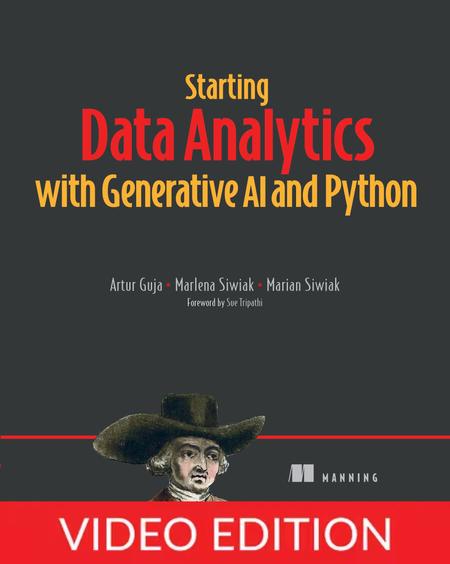English | MP4 | AVC 1280×720 | AAC 44KHz 2ch | 12h 4m | 2.23 GB
Accelerate your mastery of data analytics with the power of ChatGPT.
Whether you’re a data novice or an experienced pro looking to do more work, faster, Starting Data Analytics with Generative AI and Python is here to help simplify and speed up your data analysis! Written by a pair of world-class data scientists and an experienced risk manager, the book concentrates on the practical analytics tasks you’ll do every day.
Inside Starting Data Analytics with Generative AI and Python you’ll learn how to:
- Write great prompts for ChatGPT
- Perform end-to-end descriptive analytics
- Set up an AI-friendly data analytics environment
- Evaluate the quality of your data
- Develop a strategic analysis plan
- Generate code to analyze non-text data
- Explore text data directly with ChatGPT
- Prepare reliable reports
In Starting Data Analytics with Generative AI and Python you’ll learn how to improve your coding efficiency, generate new analytical approaches, and fine-tune data pipelines—all assisted by AI tools like ChatGPT. For each step in the data process, you’ll discover how ChatGPT can implement data techniques from simple plain-English prompts. Plus, you’ll develop a vital intuition about the risks and errors that still come with these tools.
If you have basic knowledge of data analysis, this book will show you how to use ChatGPT to accelerate your essential data analytics work. This speed-up can be amazing: the authors report needing one third or even one quarter the time they needed before.
You’ll find reliable and practical advice that works on the job. Improve problem exploration, generate new analytical approaches, and fine-tune your data pipelines—all while developing an intuition about the risks and errors that still come with AI tools. In the end, you’ll be able to do significantly more work, do it faster, and get better results, without breaking a sweat.
Assuming only that you know the foundations, this friendly book guides you through the entire analysis process—from gathering and preparing raw data, data cleaning, generating code-based solutions, selecting statistical tools, and finally creating effective data presentations. With clearly-explained prompts to extract, interpret, and present data, it will raise your skills to a whole different level.
What’s Inside
- Write great prompts for ChatGPT
- Perform end-to-end descriptive analytics
- Set up an AI-friendly data analytics environment
- Evaluate the quality of your data
- Develop a strategic analysis plan
- Generate code to analyze non-text data
- Explore text data directly with ChatGPT
- Prepare reliable reports
Table of Contents
Chapter 1. Introduction to the use of generative AI in data analytics
Chapter 1. The role of generative AIs in data analytics
Chapter 1. Getting started with generative AIs for data analytics
Chapter 1. Summary
Chapter 2. Using generative AI to ensure sufficient data quality
Chapter 2. A note on best practices
Chapter 2. Getting started
Chapter 2. Quality assessment structure
Chapter 2. Data cleaning
Chapter 2. Exploratory data analysis
Chapter 2. Summary
Chapter 3. Descriptive analysis and statistical inference supported by generative AI
Chapter 3. Analysis design
Chapter 3. Descriptive data analysis
Chapter 3. Inferential analysis
Chapter 3. Summary
Chapter 4. Using generative AI for result interpretations
Chapter 4. Popularity of product categories
Chapter 4. Performance of products in their categories and regions
Chapter 4. Review scores distribution analysis
Chapter 4. Order status
Chapter 4. Relationship between product attributes and the shipping costs
Chapter 4. Relationship between product, transaction, shipping attributes, and the review score
Chapter 4. Differences in sales performance and customer satisfaction between sellers
Chapter 4. Summary
Chapter 5. Basic text mining using generative AI
Chapter 5. Preparing for analysis
Chapter 5. Frequency analysis
Chapter 5. Co-occurrence analysis
Chapter 5. Keyword search
Chapter 5. Dictionary-based methods
Chapter 5. Summary
Chapter 6. Advanced text mining with generative AI
Chapter 6. Sentiment analysis
Chapter 6. Text summarization
Chapter 6. Summary
Chapter 7. Scaling and performance optimization
Chapter 7. Improving code performance
Chapter 7. Cloud-based deployment
Chapter 7. Code conversion
Chapter 7. Summary
Chapter 8. Risk, mitigation, and tradeoffs
Chapter 8. General best practices
Chapter 8. AI delusion and hallucination risks
Chapter 8. Mitigating misinterpretation and miscommunication risks
Chapter 8. Model bias and fairness risks
Chapter 8. Privacy and security risks
Chapter 8. Legal and compliance risks
Chapter 8. Emergent risks
Chapter 8. Summary
Appendix B. On debugging ChatGPT’s code
Appendix C. On laziness and human errors
Resolve the captcha to access the links!
